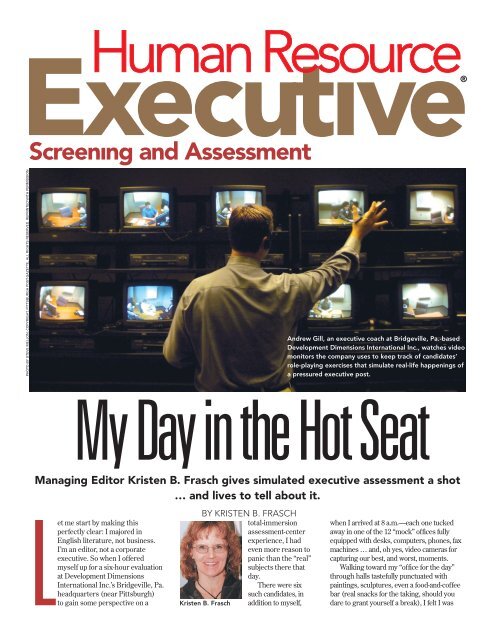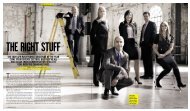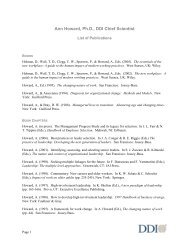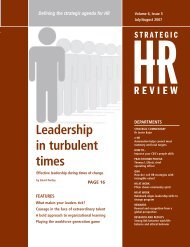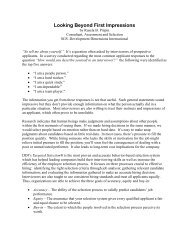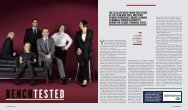Read the complete article on executive assessment. - DDI
Read the complete article on executive assessment. - DDI
Read the complete article on executive assessment. - DDI
You also want an ePaper? Increase the reach of your titles
YUMPU automatically turns print PDFs into web optimized ePapers that Google loves.
Screenıng and Assessment<br />
PHOTO BY STEVE MELLON; COPYRIGHT, PITTSBURGH POST-GAZETTE, ALL RIGHTS RESERVED. REPRINTED WITH PERMISSION<br />
Andrew Gill, an <strong>executive</strong> coach at Bridgeville, Pa.-based<br />
Development Dimensi<strong>on</strong>s Internati<strong>on</strong>al Inc., watches video<br />
m<strong>on</strong>itors <str<strong>on</strong>g>the</str<strong>on</strong>g> company uses to keep track of candidates’<br />
role-playing exercises that simulate real-life happenings of<br />
a pressured <strong>executive</strong> post.<br />
My Day in <str<strong>on</strong>g>the</str<strong>on</strong>g> Hot Seat<br />
Managing Editor Kristen B. Frasch gives simulated <strong>executive</strong> <strong>assessment</strong> a shot<br />
… and lives to tell about it.<br />
Let me start by making this<br />
perfectly clear: I majored in<br />
English literature, not business.<br />
I’m an editor, not a corporate<br />
<strong>executive</strong>. So when I offered<br />
myself up for a six-hour evaluati<strong>on</strong><br />
at Development Dimensi<strong>on</strong>s<br />
Internati<strong>on</strong>al Inc.’s Bridgeville, Pa.<br />
headquarters (near Pittsburgh)<br />
to gain some perspective <strong>on</strong> a<br />
BY KRISTEN B. FRASCH<br />
total-immersi<strong>on</strong><br />
<strong>assessment</strong>-center<br />
experience, I had<br />
even more reas<strong>on</strong> to<br />
panic than <str<strong>on</strong>g>the</str<strong>on</strong>g> “real”<br />
subjects <str<strong>on</strong>g>the</str<strong>on</strong>g>re that<br />
day.<br />
There were six<br />
such candidates, in<br />
additi<strong>on</strong> to myself,<br />
Kristen B. Frasch<br />
when I arrived at 8 a.m.—each <strong>on</strong>e tucked<br />
away in <strong>on</strong>e of <str<strong>on</strong>g>the</str<strong>on</strong>g> 12 “mock” offices fully<br />
equipped with desks, computers, ph<strong>on</strong>es, fax<br />
machines … and, oh yes, video cameras for<br />
capturing our best, and worst, moments.<br />
Walking toward my “office for <str<strong>on</strong>g>the</str<strong>on</strong>g> day”<br />
through halls tastefully punctuated with<br />
paintings, sculptures, even a food-and-coffee<br />
bar (real snacks for <str<strong>on</strong>g>the</str<strong>on</strong>g> taking, should you<br />
dare to grant yourself a break), I felt I was<br />
54 Human Resource Executive ®
already being immersed in as professi<strong>on</strong>al<br />
and corporate a setting as possible—without<br />
its really being that, of course.<br />
By <str<strong>on</strong>g>the</str<strong>on</strong>g> time I reached my door,<br />
unpacked my briefcase and bel<strong>on</strong>gings, and<br />
readied myself for instructi<strong>on</strong>s from Jean<br />
Denuzzio, <str<strong>on</strong>g>the</str<strong>on</strong>g> <strong>executive</strong> coach and team<br />
leader in charge of <str<strong>on</strong>g>the</str<strong>on</strong>g> <strong>assessment</strong> exercise,<br />
I was already breaking into a cold sweat.<br />
Granted, in <str<strong>on</strong>g>the</str<strong>on</strong>g> weeks leading up to<br />
my trip, I had pored over my “role” (my<br />
name would be Kelly Myers) and <str<strong>on</strong>g>the</str<strong>on</strong>g><br />
mock company I would be joining that<br />
day—my first <strong>on</strong> <str<strong>on</strong>g>the</str<strong>on</strong>g> job—as vice president<br />
of commercial operati<strong>on</strong>s for a robotics<br />
manufacturer, GS Robotics Inc., a divisi<strong>on</strong> of<br />
Global Soluti<strong>on</strong>s Inc., in <str<strong>on</strong>g>the</str<strong>on</strong>g> year 2025.<br />
The material was impressively<br />
thorough—reams of financials, company<br />
histories, hierarchy charts, product<br />
descripti<strong>on</strong>s, global breakdowns—enough<br />
serious business c<strong>on</strong>cerns and details to<br />
make a former English major and l<strong>on</strong>gtime<br />
journalist yearn for some o<str<strong>on</strong>g>the</str<strong>on</strong>g>r approach to<br />
this story than a firsthand account.<br />
Curiosity got <str<strong>on</strong>g>the</str<strong>on</strong>g> best of me, though,<br />
and I decided not to chicken out. I was as<br />
interested in witnessing <str<strong>on</strong>g>the</str<strong>on</strong>g> simulati<strong>on</strong><br />
<strong>assessment</strong>-center c<strong>on</strong>cept—a method<br />
dating back to <str<strong>on</strong>g>the</str<strong>on</strong>g> U.S. Army’s War Office<br />
Selecti<strong>on</strong> Boards and post-World War II<br />
Office of Strategic Services, and later initially<br />
put to corporate use by AT&T—as I was<br />
in seeing how a n<strong>on</strong>-business-schooled<br />
candidate might pull this off.<br />
As unreal as <str<strong>on</strong>g>the</str<strong>on</strong>g> company and its<br />
products were by today’s standards, its<br />
challenges and problems were very real.<br />
Clearly, I thought, some keen business<br />
heads went to great lengths to put<br />
toge<str<strong>on</strong>g>the</str<strong>on</strong>g>r <str<strong>on</strong>g>the</str<strong>on</strong>g> kind of company background,<br />
organizati<strong>on</strong>al design, financial pressures<br />
and c<strong>on</strong>cerns, and even petty politics<br />
and scenarios that could test any wouldbe<br />
<strong>executive</strong> with excepti<strong>on</strong>al MBAgraduate-level<br />
capabilities. Revenue goals<br />
were not being met and some divisi<strong>on</strong>s<br />
were becoming obsolete, while not<br />
enough creativity and innovati<strong>on</strong> was<br />
being applied to new-product design,<br />
overseas opportunities and companywide<br />
commitment to shared goals.<br />
Once I was set up, <str<strong>on</strong>g>the</str<strong>on</strong>g> e-mails started<br />
coming, <strong>on</strong>e <strong>on</strong> top of <str<strong>on</strong>g>the</str<strong>on</strong>g> o<str<strong>on</strong>g>the</str<strong>on</strong>g>r. I had<br />
fires to put out. L<strong>on</strong>g-time divisi<strong>on</strong> chiefs<br />
were waging turf wars and I’d be getting<br />
a ph<strong>on</strong>e call in precisely 15 minutes (Say<br />
what?!) to c<strong>on</strong>sult <strong>on</strong>e bearer of ruffled<br />
fea<str<strong>on</strong>g>the</str<strong>on</strong>g>rs—<str<strong>on</strong>g>the</str<strong>on</strong>g> l<strong>on</strong>gtime managing director<br />
of a European company we had acquired a<br />
year before. Cig Chevalier, my boss let me<br />
know in an e-mail, “c<strong>on</strong>tinues to ignore <str<strong>on</strong>g>the</str<strong>on</strong>g><br />
commercial possibilities and is reluctant to<br />
share technology” and <str<strong>on</strong>g>the</str<strong>on</strong>g> expertise of his<br />
people with our internati<strong>on</strong>ally expanding<br />
corporati<strong>on</strong>. I had some comforting to do:<br />
I was to assure him his company’s name,<br />
Robotiques Astral Chevalier Limitee (RAC),<br />
and reputati<strong>on</strong> would stay intact. I had some<br />
cajoling to do: I had to think of a way we<br />
could tap into his company’s talent without<br />
depleting his ranks and productivity. And<br />
I had some tough managing to do: He<br />
needed to hear from me that being an<br />
active, collaborative part of our company<br />
was not an opti<strong>on</strong> anymore. We expected<br />
his cooperati<strong>on</strong>.<br />
With <str<strong>on</strong>g>the</str<strong>on</strong>g> clock ticking and my mouth<br />
drying, I tried combing through <str<strong>on</strong>g>the</str<strong>on</strong>g> company<br />
chart to make sure I had <str<strong>on</strong>g>the</str<strong>on</strong>g> divisi<strong>on</strong>s and<br />
players straight.<br />
But wait! O<str<strong>on</strong>g>the</str<strong>on</strong>g>r e-mails were appearing<br />
in my bin. I’d be getting a visitor in 45<br />
minutes (Oh boy!), a disgruntled divisi<strong>on</strong>al<br />
director in my unit by <str<strong>on</strong>g>the</str<strong>on</strong>g> name of Marty<br />
Kane, whose manufacturing arm—under<br />
his leadership—needed some stern pointers<br />
<strong>on</strong> how to adhere to <str<strong>on</strong>g>the</str<strong>on</strong>g> newly aligned<br />
corporate structure.<br />
Seems Marty was hardly inspiring<br />
support for <str<strong>on</strong>g>the</str<strong>on</strong>g> new corporate sales and<br />
marketing efforts that went into effect<br />
about six m<strong>on</strong>ths ago, and, as a result, <str<strong>on</strong>g>the</str<strong>on</strong>g><br />
reputati<strong>on</strong> of Commercial Robotics—my<br />
baby—was suffering.<br />
There were o<str<strong>on</strong>g>the</str<strong>on</strong>g>r problems I had to<br />
digest, some PR nightmares surrounding<br />
malfuncti<strong>on</strong>s and mixed signals in certain<br />
robots—including <str<strong>on</strong>g>the</str<strong>on</strong>g> “English-speaking”<br />
domestic model sold to a wealthy<br />
Frenchman. According to various news<br />
reports, <str<strong>on</strong>g>the</str<strong>on</strong>g> robot mistook <str<strong>on</strong>g>the</str<strong>on</strong>g> English<br />
word “shoe” for <str<strong>on</strong>g>the</str<strong>on</strong>g> French “chou,” which<br />
means cabbage. The customer had ordered<br />
cabbage for dinner. The robot cooked and<br />
served up his shoes.<br />
The name “GS Robotics” was all over a<br />
snide but humorous account in a French<br />
daily newspaper. (These guys at <strong>DDI</strong> thought<br />
of everything.) What was dawning <strong>on</strong> me<br />
through <str<strong>on</strong>g>the</str<strong>on</strong>g> course of my informati<strong>on</strong><br />
<strong>on</strong>slaught was <str<strong>on</strong>g>the</str<strong>on</strong>g> clear and pressing need<br />
for better synergy between technical and<br />
marketing teams throughout <str<strong>on</strong>g>the</str<strong>on</strong>g> company,<br />
and <str<strong>on</strong>g>the</str<strong>on</strong>g> potential this had to boost sagging<br />
margins. How I would translate and oversee<br />
this was ano<str<strong>on</strong>g>the</str<strong>on</strong>g>r matter.<br />
L<strong>on</strong>g story short, I got through my<br />
meetings and ph<strong>on</strong>e calls, and even<br />
schmoozed my way through presenting a<br />
business plan to my “boss,” Terry Turner, at<br />
<str<strong>on</strong>g>the</str<strong>on</strong>g> end of <str<strong>on</strong>g>the</str<strong>on</strong>g> day—something I, pers<strong>on</strong>ally,<br />
had never written in my life until <str<strong>on</strong>g>the</str<strong>on</strong>g>n.<br />
I basically summ<strong>on</strong>ed up all <str<strong>on</strong>g>the</str<strong>on</strong>g><br />
research, organizati<strong>on</strong>al, intuitive and<br />
persuasive skills in my arsenal to get<br />
through it. Granted, I was in over my head<br />
in terms of viable bottom-line soluti<strong>on</strong>s<br />
an <strong>executive</strong> might drum up to solve<br />
some very real and pressing business<br />
challenges. But, according to my boss,<br />
who patiently sat through my defense, I<br />
had some sound ideas <strong>on</strong> ways we might<br />
improve communicati<strong>on</strong> and cooperati<strong>on</strong><br />
between divisi<strong>on</strong>s, and between our U.S.<br />
and overseas sites. (Or maybe he was just<br />
being kind.)<br />
When he left, I put down my notes and<br />
pen and uttered <str<strong>on</strong>g>the</str<strong>on</strong>g> <strong>on</strong>ly remaining word in<br />
my brain: “Wow.” Being brand new to this<br />
experience, which would be hard to translate<br />
to <str<strong>on</strong>g>the</str<strong>on</strong>g> world of journalism anyway, I came<br />
away knowing <str<strong>on</strong>g>the</str<strong>on</strong>g>y just saw everything—<br />
my strengths, weaknesses, knowledge,<br />
temperament and threshold for multitasking<br />
under pressure.<br />
I also knew that, had I been vying for a<br />
top-level <strong>executive</strong> post or promoti<strong>on</strong>, I would<br />
have just been through about as <str<strong>on</strong>g>complete</str<strong>on</strong>g> an<br />
appraisal as <str<strong>on</strong>g>the</str<strong>on</strong>g>re could be.<br />
The business knowledge and<br />
improvisati<strong>on</strong>al skills of <str<strong>on</strong>g>the</str<strong>on</strong>g> role-players<br />
also left me humbled and fairly speechless.<br />
They were so locked into <str<strong>on</strong>g>the</str<strong>on</strong>g>ir characters, I<br />
wasn’t about to budge from mine. There was<br />
absolutely nothing relaxed about any of it.<br />
Behind <str<strong>on</strong>g>the</str<strong>on</strong>g> Scenes<br />
A lot goes into what I had just<br />
experienced, and what about 2,650 <strong>executive</strong><br />
candidates experience each year in any of<br />
<strong>DDI</strong>’s 75 offices in 26 countries throughout<br />
<str<strong>on</strong>g>the</str<strong>on</strong>g> world, says Chairman and CEO William<br />
C. Byham.<br />
Key to <str<strong>on</strong>g>the</str<strong>on</strong>g> <strong>DDI</strong> process, and its<br />
str<strong>on</strong>gest differentiator, he says, is <str<strong>on</strong>g>the</str<strong>on</strong>g> “data<br />
integrati<strong>on</strong>” factor. For every pers<strong>on</strong> put<br />
through this type of grilling, three different<br />
assessors are listening to different parts of his<br />
or her performance and making his or her<br />
own qualitative and quantitative evaluati<strong>on</strong>s.<br />
“Then <str<strong>on</strong>g>the</str<strong>on</strong>g> assessors get toge<str<strong>on</strong>g>the</str<strong>on</strong>g>r and<br />
‘sell <str<strong>on</strong>g>the</str<strong>on</strong>g>ir evaluati<strong>on</strong>s,’ ” which include<br />
scores from <strong>on</strong>e to five <strong>on</strong> a whole string of<br />
competencies as well as general arguments<br />
for or against certain strengths, says<br />
Byham. The group <str<strong>on</strong>g>the</str<strong>on</strong>g>n interprets those<br />
competencies in terms of <str<strong>on</strong>g>the</str<strong>on</strong>g> business’ goals<br />
and <str<strong>on</strong>g>the</str<strong>on</strong>g> job, or promoti<strong>on</strong>, <str<strong>on</strong>g>the</str<strong>on</strong>g> pers<strong>on</strong> is vying<br />
for. Real candidates get psychological tests<br />
as well, to fur<str<strong>on</strong>g>the</str<strong>on</strong>g>r c<strong>on</strong>firm, or deny, <str<strong>on</strong>g>the</str<strong>on</strong>g>ir<br />
fit—something I was spared.<br />
All <strong>assessment</strong> firms—experts tell me<br />
<str<strong>on</strong>g>the</str<strong>on</strong>g>re are a few dozen worldwide, including<br />
<str<strong>on</strong>g>the</str<strong>on</strong>g> smaller, regi<strong>on</strong>al sites—put <str<strong>on</strong>g>the</str<strong>on</strong>g>ir own<br />
spin <strong>on</strong> <str<strong>on</strong>g>the</str<strong>on</strong>g> approach. Minneapolis-based<br />
Pers<strong>on</strong>nel Decisi<strong>on</strong>s Internati<strong>on</strong>al, <str<strong>on</strong>g>the</str<strong>on</strong>g> <strong>on</strong>ly<br />
o<str<strong>on</strong>g>the</str<strong>on</strong>g>r <strong>assessment</strong> firm <strong>on</strong> <str<strong>on</strong>g>the</str<strong>on</strong>g> global scale of<br />
<strong>DDI</strong>, uses what Vice President and General<br />
Manager R.J. Heckman calls <str<strong>on</strong>g>the</str<strong>on</strong>g> “anchoredrating-scale”<br />
approach—even l<strong>on</strong>ger lists<br />
of calibrated standards each individual is
Screenıng and Assessment<br />
PHOTO COURTESY OF DEVELOPMENT DIMENSIONS INTERNATIONAL INC., PITTSBURGH<br />
Members of a data-integrati<strong>on</strong> team c<strong>on</strong>fer after a candidate <str<strong>on</strong>g>complete</str<strong>on</strong>g>s a day-l<strong>on</strong>g<br />
exercise at <str<strong>on</strong>g>the</str<strong>on</strong>g> Development Dimensi<strong>on</strong>s Internati<strong>on</strong>al Inc.’s <strong>assessment</strong> center.<br />
scored against by <strong>on</strong>e assessor.<br />
Assessment experts have <str<strong>on</strong>g>the</str<strong>on</strong>g>ir takes<br />
<strong>on</strong> this immersi<strong>on</strong> process too, and where<br />
it’s headed. John Boudreau, professor<br />
of management and organizati<strong>on</strong> at<br />
<str<strong>on</strong>g>the</str<strong>on</strong>g> University of Sou<str<strong>on</strong>g>the</str<strong>on</strong>g>rn California’s<br />
Marshall School of Business, c<strong>on</strong>siders<br />
it, “from a psychological-measurement<br />
perspective, [successful in meeting] more<br />
of <str<strong>on</strong>g>the</str<strong>on</strong>g> standards of good research design<br />
than more informal methods of <strong>executive</strong><br />
<strong>assessment</strong>.”<br />
But <str<strong>on</strong>g>the</str<strong>on</strong>g> future still probably holds some<br />
necessary adjustments, he says. “Due to <str<strong>on</strong>g>the</str<strong>on</strong>g><br />
need to span many different industries and<br />
ec<strong>on</strong>omic strategies, such approaches are<br />
often somewhat generic, and may or may not<br />
get at <str<strong>on</strong>g>the</str<strong>on</strong>g> vital specific factors that will really<br />
lead to competitive advantage through better<br />
leadership.<br />
“A standard set of competencies<br />
across many organizati<strong>on</strong>s (including<br />
competitors),” he says, “can create a<br />
better-quality outcome for all, but may<br />
not create <str<strong>on</strong>g>the</str<strong>on</strong>g> specific strategic outcome<br />
that might have a high payoff for any <strong>on</strong>e<br />
organizati<strong>on</strong>.”<br />
Indeed, <str<strong>on</strong>g>the</str<strong>on</strong>g> jury’s still out <strong>on</strong> how<br />
prevalent this kind of <strong>assessment</strong> will be<br />
in <str<strong>on</strong>g>the</str<strong>on</strong>g> future, according to Peter Cappelli,<br />
George W. Taylor professor of management<br />
at <str<strong>on</strong>g>the</str<strong>on</strong>g> Whart<strong>on</strong> School in Philadelphia and<br />
director of Whart<strong>on</strong>’s Center for Human<br />
Resources.<br />
“The research <strong>on</strong> <strong>assessment</strong> centers<br />
56 Human Resource Executive ®<br />
as predictive devices is a little mixed in<br />
terms of predicting future job performance,”<br />
Cappelli says. “It suggests that <strong>assessment</strong>center<br />
informati<strong>on</strong> doesn’t add a lot bey<strong>on</strong>d<br />
what we could already know about current<br />
performance in roles—although some<br />
employers have such lousy <strong>assessment</strong>s of<br />
<str<strong>on</strong>g>the</str<strong>on</strong>g>ir employees that <str<strong>on</strong>g>the</str<strong>on</strong>g>y essentially know<br />
little about <str<strong>on</strong>g>the</str<strong>on</strong>g>m.<br />
“An alternative, which can be, in<br />
<str<strong>on</strong>g>the</str<strong>on</strong>g> right circumstances, cheaper than<br />
<strong>assessment</strong> centers, is to give people<br />
<str<strong>on</strong>g>the</str<strong>on</strong>g> opportunity to try out actual roles or<br />
“Assessment centers<br />
excel because<br />
people take acti<strong>on</strong> to<br />
improve <str<strong>on</strong>g>the</str<strong>on</strong>g>mselves<br />
when <str<strong>on</strong>g>the</str<strong>on</strong>g>y feel<br />
<str<strong>on</strong>g>the</str<strong>on</strong>g>y’ve been allowed<br />
to perform [and be<br />
seen] at <str<strong>on</strong>g>the</str<strong>on</strong>g>ir top<br />
level. You accept <str<strong>on</strong>g>the</str<strong>on</strong>g><br />
process when you<br />
feel you’ve been<br />
seen. ”<br />
tasks in a c<strong>on</strong>text where <str<strong>on</strong>g>the</str<strong>on</strong>g> downside<br />
risk is low,” he says. “Nothing beats<br />
current performance as a predictor of<br />
future performance, and nothing is more<br />
realistic—for <str<strong>on</strong>g>the</str<strong>on</strong>g> individual as well—as<br />
actually trying out a positi<strong>on</strong>.”<br />
Never<str<strong>on</strong>g>the</str<strong>on</strong>g>less, he adds, “I think<br />
individuals can always learn from <str<strong>on</strong>g>the</str<strong>on</strong>g>se<br />
<strong>assessment</strong>-center approaches about<br />
<str<strong>on</strong>g>the</str<strong>on</strong>g>mselves.”<br />
Looking to <str<strong>on</strong>g>the</str<strong>on</strong>g> future, both <strong>DDI</strong> and PDI<br />
are already getting very good at customfitting<br />
<strong>assessment</strong> exercises to correlate<br />
more closely with <str<strong>on</strong>g>the</str<strong>on</strong>g> business needs and<br />
goals of <str<strong>on</strong>g>the</str<strong>on</strong>g>ir client companies.<br />
Like many o<str<strong>on</strong>g>the</str<strong>on</strong>g>r <strong>assessment</strong> firms, <str<strong>on</strong>g>the</str<strong>on</strong>g>y’re<br />
also expanding <str<strong>on</strong>g>the</str<strong>on</strong>g>ir post-<strong>assessment</strong> training<br />
and coaching services as well.<br />
“What we’re very interested in now is<br />
whe<str<strong>on</strong>g>the</str<strong>on</strong>g>r people take acti<strong>on</strong> with this,” says<br />
Byham. “Assessment centers excel because<br />
people take acti<strong>on</strong> to improve <str<strong>on</strong>g>the</str<strong>on</strong>g>mselves<br />
when <str<strong>on</strong>g>the</str<strong>on</strong>g>y feel <str<strong>on</strong>g>the</str<strong>on</strong>g>y’ve been allowed to<br />
perform [and be seen] at <str<strong>on</strong>g>the</str<strong>on</strong>g>ir top level. You<br />
accept <str<strong>on</strong>g>the</str<strong>on</strong>g> process when you feel you’ve<br />
been seen.”<br />
Both Byham and Heckman see<br />
companies in <str<strong>on</strong>g>the</str<strong>on</strong>g> future holding more<br />
<strong>assessment</strong>s designed to help <str<strong>on</strong>g>the</str<strong>on</strong>g>m evaluate<br />
overall leadership strength and alignment<br />
with newly enhanced goals as opposed to<br />
<str<strong>on</strong>g>the</str<strong>on</strong>g> more simplified process of selecting<br />
<str<strong>on</strong>g>the</str<strong>on</strong>g> best-qualified job candidates vying for<br />
particular posts.<br />
As Heckman puts it, “a lot of CEOs call<br />
us and say, ‘We need to really understand<br />
how str<strong>on</strong>g our senior <strong>executive</strong>s are,’ ” as<br />
leaders of a whole new corporate initiative<br />
or directi<strong>on</strong>, let’s say. There might not even<br />
be promoti<strong>on</strong>s or jobs at stake in a growing<br />
number of client requests that come through<br />
<strong>assessment</strong>-companies’ doors.<br />
Never<str<strong>on</strong>g>the</str<strong>on</strong>g>less, <str<strong>on</strong>g>the</str<strong>on</strong>g> purpose will always be<br />
to get <str<strong>on</strong>g>the</str<strong>on</strong>g> most <str<strong>on</strong>g>complete</str<strong>on</strong>g> look possible at how<br />
some<strong>on</strong>e works, <str<strong>on</strong>g>the</str<strong>on</strong>g> process through which<br />
decisi<strong>on</strong>s are made and communicati<strong>on</strong>s<br />
are sent, <str<strong>on</strong>g>the</str<strong>on</strong>g> basic knowledge base, <str<strong>on</strong>g>the</str<strong>on</strong>g><br />
preparati<strong>on</strong> time allotted for each new<br />
challenge and a pers<strong>on</strong>’s ability to juggle<br />
ever-shifting priorities during a typical whiteknuckle<br />
corporate day.<br />
Leaving <strong>DDI</strong>, I saw a few candidates<br />
still sweating it out in <str<strong>on</strong>g>the</str<strong>on</strong>g>ir “offices,” taking<br />
fateful knocks or ph<strong>on</strong>e calls from pretend<br />
sources of pretend problems <str<strong>on</strong>g>the</str<strong>on</strong>g>y’d have to<br />
solve in very real ways. I could almost feel<br />
<str<strong>on</strong>g>the</str<strong>on</strong>g> heat rising up <str<strong>on</strong>g>the</str<strong>on</strong>g>ir backs as I turned<br />
mine, happy to have survived my schooling<br />
into just how revealing today’s <strong>executive</strong><br />
<strong>assessment</strong> can be.<br />
Send questi<strong>on</strong>s or comments about this story<br />
to hreletters@lrp.com.<br />
REPRINTED FROM HUMAN RESOURCE EXECUTIVE®, JUNE 16TH, 2007, COPYRIGHT© 2007 ALL RIGHTS RESERVED.


